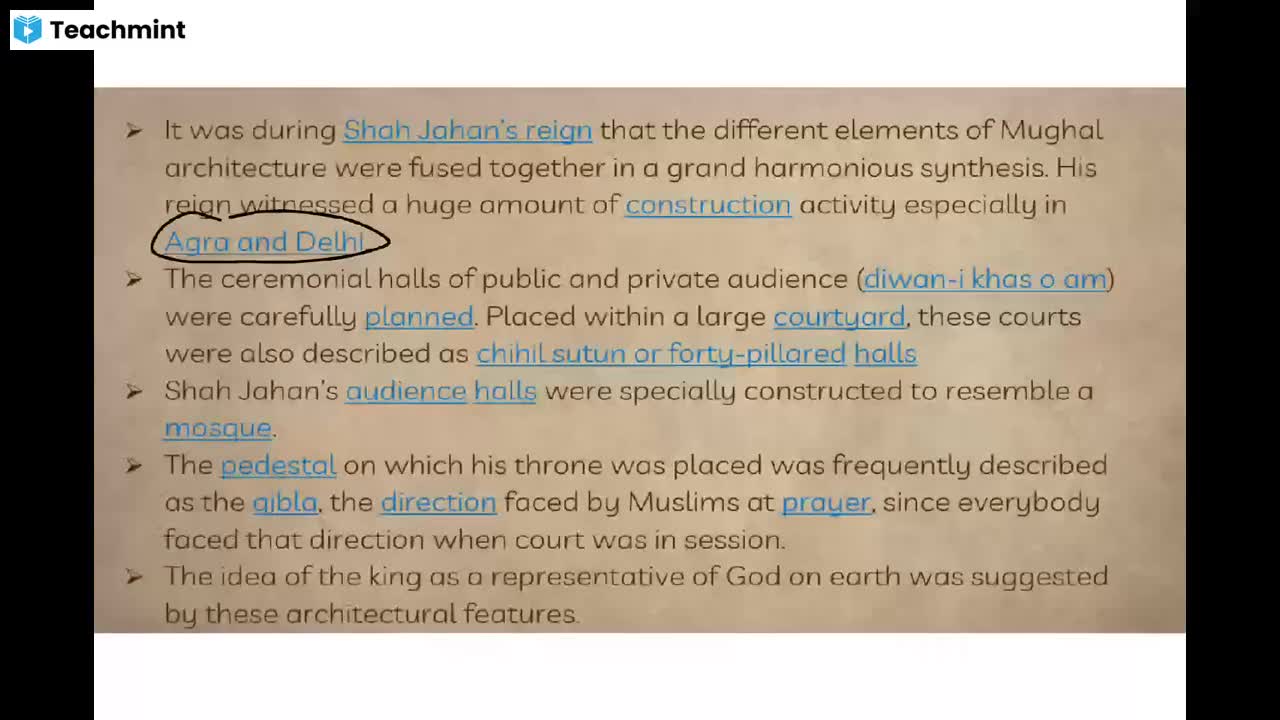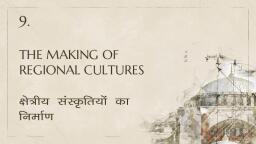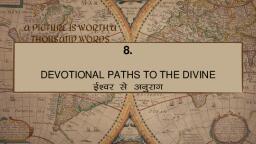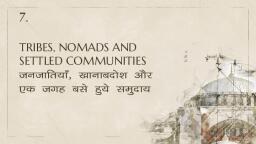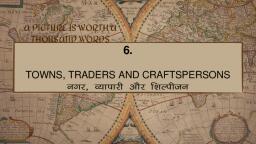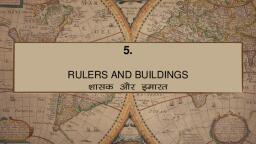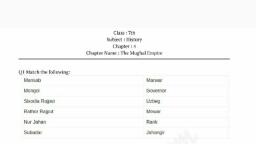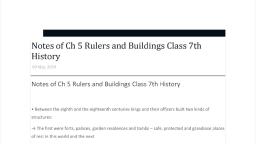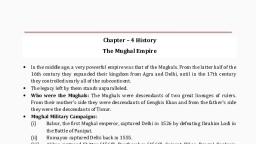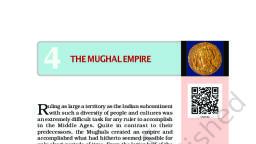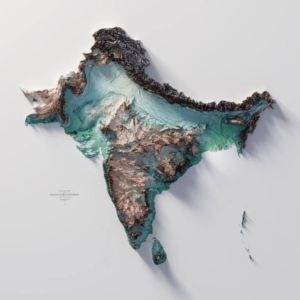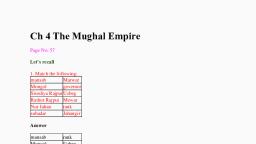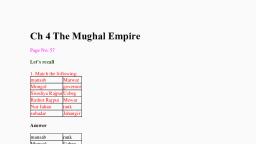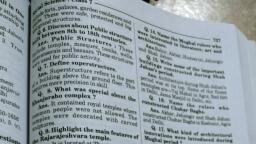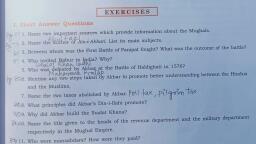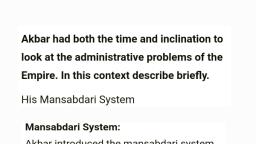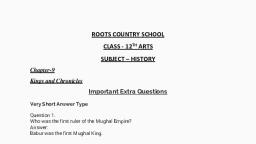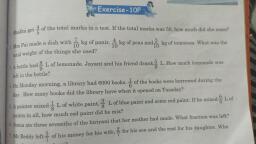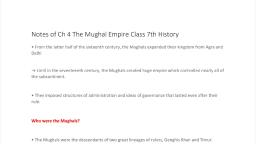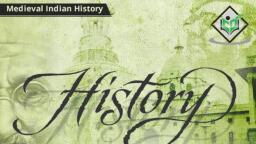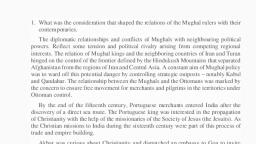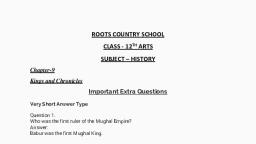Page 2 :
OVERVIEW, 1., 2., 3., 4., 5., 6., 7., 8., , WHO WERE THE MUGHALS ?, MUGHAL MILITARY CAMPAIGNS, MUGHAL TRADITIONS OF SUCCESSION, MUGHAL RELATIONS WITH OTHER RULERS, MANSABDARS AND JAGIRDARS, ZABT AND ZAMINDARS, A CLOSER LOOK: AKBAR’S POLICIES, THE MUGHAL EMPIRE IN THE SEVENTEENTH CENTURY AND, AFTER, 9. KINGS AND QUEENS, 4
Page 3 :
⬗ The mughals created an empire and accomplished what had, hitherto seemed possible for only short periods of time., , ⬗ From the latter half of the sixteenth century they expanded their, kingdom from Agra and Delhi, until in the seventeenth century, they controlled nearly all of the subcontinent., ⬗ They imposed structures of administration and ideas of, governance that outlasted their rule, leaving a political legacy that, succeeding rulers of the subcontinent could not ignore, 5
Page 4 :
Who were the Mughals?, ✓ The Mughals were descendants of two great lineages of rulers :, 1. From their mother’s side they were descendants of Genghis Khan, (died 1227), the Mongol ruler who ruled over parts of China and, Central Asia., 2. From their father’s side they were the successors of Timur (died, 1404), the ruler of Iran, Iraq and modern-day Turkey., , 6
Page 5 :
⬗ The Mughals did not like to be called Mughal or Mongol. This was because, Genghis Khan’s memory was associated with the massacre of innumerable, people. It was also linked, with the Uzbegs, their, Mongol competitors., , ⬗ On the other hand, the, , 7, , Mughals were proud of, their Timurid ancestry,, not least of all because, their great ancestor had, captured Delhi in 1398. They celebrated their genealogy pictorially, each ruler, getting a picture made of Timur and himself.
Page 6 :
⬗ A miniature painting (y?kqfp= ) (dated 1702-1712) of Timur, his, , descendants and the Mughal emperors., ⬗ Timur is in the centre and on his right is his son Miran Shah (the first, Mughal emperor Babur’s great-greatgrandfather) and then Abu Said, (Babur’s grandfather)., ⬗ To the left of Timur are Sultan Muhammad Mirza (Babur’s greatgrandfather) and Umar Shaikh (Babur’s father)., ⬗ The Mughal emperors Babur, Akbar and Shah Jahan are the third, fourth, and fifth individuals on Timur’s right and on his left, in the same order, are, Humayun, Jahangir and Aurangzeb, , 8
Page 8 :
⬗ Cannons were an important addition in, , sixteenth-century warfare. Babur used them, effectively in the first battle of Panipat., ⬗ Gun powder technology was brought to, India for warfare in the 14th century., ⬗ Fire arms were used for the first time in, regions such as Gujarat, Malwa and Deccan,, and was used by Babur in early 16th century., , 10
Page 9 :
11
Page 10 :
12
Page 11 :
13
Page 12 :
14
Page 13 :
Military, campaigns under, Akbar and, Aurangzeb, , 15
Page 15 :
Mughal Relations with Other Rulers, ➢The Mughal rulers campaigned constantly against rulers who refused to accept, their authority. But as the Mughals became powerful many other rulers also, joined them voluntarily., ➢ The Rajputs are a good example of this. Many of them married their daughters, into Mughal families and received high positions. But, many resisted as well., ⬗ The Sisodiya Rajputs of Mewar refused to accept Mughal authority for a long, time. Once defeated, however, they were honourably treated by the Mughals, given, their lands (watan) back as assignments (watan jagir)., ⬗ The careful balance between defeating but not humiliating their opponents, enabled the Mughals to extend their influence over many kings and chieftains. But, it was difficult to keep this balance all the time., , 17
Page 16 :
Mansabdars and Jagirdars, eulcnkj vkSj tkxhjnkj, ➢ As the empire expanded to encompass different regions the Mughals, recruited diverse bodies of people. From a small nucleus of Turkish, nobles (Turanis) they expanded to include Iranians, Indian Muslims,, Afghans, Rajputs, Marathas and other groups., ➢ Those who joined Mughal service were enrolled as MANSABDARS, , ➢ The term mansabdar refers to an individual who holds a mansab,, meaning a position or rank., 18
Page 17 :
Mansabdars and Jagirdars, eulcnkj vkSj tkxhjnkj, ➢ Mansabdar was a grading system used by the Mughals to fix, (1) rank,, (2) salary and, (3) military responsibilities., , ➢Rank and salary were determined by a numerical value called zat., ➢ The higher the zat, the more prestigious was the noble’s position, in court and the larger his salary., , 19
Page 18 :
➢The mansabdar’s military responsibilities required him to maintain a, specified number of sawar or cavalrymen. The mansabdar brought his, cavalrymen for review, got them registered, their horses branded and then, received money to pay them as salary., ➢ Mansabdars received their salaries as revenue assignments called jagirs which, were somewhat like iqtas. But unlike muqtis, most mansabdars did not, actually reside in or administer their jagirs., ➢They only had rights to the revenue of their assignments which was collected, for them by their servants while the mansabdars themselves served in some, other part of the country., 20
Page 19 :
➢In Akbar’s reign these jagirs were carefully assessed so that their revenues were, roughly equal to the salary of the mansabdar, ➢By Aurangzeb’s reign this was no longer the case and the actual revenue, collected was often less than the granted sum. There was also a huge increase in, the number of mansabdars, which meant a long wait before they received a, jagir., ➢ These and other factors created a shortage in the number of jagirs., ➢As a result, many jagirdars tried to extract as much revenue as possible while, they had a jagir. Aurangzeb was unable to control these developments in the, last years of his reign and the peasantry therefore suffered tremendously., 21
Page 20 :
Zat ranking ( tkr dh Jsf.k;k), Nobles with a zat of 5,000 were ranked higher than those of 1,000. In Akbar’s, reign there were 29 mansabdars with a rank of 5,000 zat; by Aurangzeb’s reign, the number of mansabdars had increased to 79., , A mansabdar on, march with his, sawars., , 22
Page 21 :
Details from a miniature from Shah, Jahan’s reign depicting corruption in his, father’s administration:, , (1) a corrupt officer receiving a bribe and, (2) a tax-collector punishing poor, peasants., , 23
Page 22 :
Zabt and Zamindars ( tCr vkSj tehaa nkj), ➢ The main source of income available to Mughal rulers was tax on the, produce of the peasantry., , ➢In most places, peasants paid taxes through the rural elites, that is, the, headman or the local chieftain., ➢The Mughals used one term – zamindars – to describe all intermediaries,, whether they were local headmen of villages or powerful chieftains., , 24
Page 23 :
Zabt and Zamindars, ➢ Akbar’s revenue minister, Todar Mal, carried out a careful survey of crop, yields, prices and areas cultivated for a 10-year period, 1570- 1580., ➢On the basis of this data, tax was fixed on each crop in cash. Each province, was divided into revenue circles with its own schedule of revenue rates for, individual crops. This revenue system was known as zabt., ➢It was prevalent in those areas where Mughal administrators could survey, the land and keep very careful accounts. This was not possible in provinces, such as Gujarat and Bengal., , 25
Page 24 :
Zabt and Zamindars, ➢ In some areas the zamindars exercised a great deal of power. The, exploitation by Mughal administrators could drive them to rebellion., Sometimes zamindars and peasants of the same caste allied in rebelling, against Mughal authority., , ➢ These peasant revolts challenged the stability of the Mughal Empire from, the end of the seventeenth century., , 26
Page 25 :
Akbar Nama and Ain-i Akbari, Akbar ordered one of his close friends and courtiers, Abul, Fazl, to write a history of his reign. Abul Fazl wrote a, three-volume history of Akbar’s reign, titled Akbar Nama., The first volume dealt with Akbar’s ancestors and the, second volume recorded the events of Akbar’s reign., The third volume is the Ain-i Akbari. It deals with, Akbar’s administration, household, army, the revenues, and the geography of his empire. It also provides rich, details about the traditions and culture of the people, living in India. The most interesting aspect about the Aini Akbari is its rich statistical details about things as diverse, as crops, yields, prices, wages and revenues., 27
Page 26 :
A Closer Look: Akbar’s Policies (vdcj dh uhfr;k¡, The broad features of administration were laid down by Akbar and were, elaborately discussed by Abul Fazl in his book, the Akbar Nama, in particular in its, last volume, the Ain-i Akbari., Abul Fazl explained that the empire was divided into provinces called subas,, governed by a subadar who carried out both political and military functions., Each province also had a financial officer or diwan., For the maintenance of peace and order in his province, the subadar was supported, by other officers such as the military paymaster (bakhshi), the minister in charge of, religious and charitable patronage (sadr), military commanders (faujdars) and the, town police commander (kotwal)., 28
Page 28 :
Nur Jahan’s influence in Jahangir’s court, The document is an order (farman), of Nur Jahan., The square seal states, “Command of, her most Sublime and Elevated, Majesty Nur Jahan Padshah Begum”., The round seal states, “by the sun of, Shah Jahangir she became as brilliant, as the moon; may Nur Jahan, Padshah be the lady of the age”., 30
Page 29 :
Akbar’s nobles commanded large armies and had access to large amounts of, revenue. While they were loyal the empire functioned efficiently but by the, end of the seventeenth century many nobles had built independent networks, of their own. Their loyalties to the empire were weakened by their own selfinterest., While Akbar was at Fatehpur Sikri during the 1570s he started discussions on, religion with the ulama, Brahmanas, Jesuit priests who were Roman, Catholics, and Zoroastrians., These discussions took place in the ibadat khana., , 31
Page 30 :
He was interested in the religion and social customs of different people. Akbar’s, interaction with people of different faiths made him realise that religious scholars, who emphasised ritual and dogma were often bigots., Their teachings created divisions and disharmony amongst his subjects. This, eventually led Akbar to the idea of sulh-i kul or “universal peace”., This idea of tolerance did not discriminate between people of different religions, in his realm. Instead it focused on a system of ethics – honesty, justice, peace –, that was universally applicable., Abul Fazl helped Akbar in framing a vision of governance around this idea of, sulh-i kul. This principle of governance was followed by Jahangir and Shah Jahan, as well., 32
Page 31 :
Dogma (erka/Irk), A statement or an interpretation declared as authoritative with the expectation that it, would be followed without question., Bigot, An individual who is intolerant of another person’s religious beliefs or culture., , Akbar holding discussions with learned individuals, of different faiths in the ibadat khana., , 33
Page 32 :
Akbar commissioned the translation of many Sanskrit works into, Persian., A Maktab Khana or translation bureau was also established at, Fatehpur Sikri for this purpose., The Mahabharata, Ramayana, Lilavati and Yogavashisht were some, of the notable Sanskrit works that were taken up for translation., The Razmnamah, Persian translation of the Mahabharata contains, lavish illustrations of the events of Mahabharata., 34
Page 33 :
35
Page 34 :
The Mughal Empire in the Seventeenth Century, and After, , The administrative and military efficiency of the Mughal Empire led to great, economic and commercial prosperity., International travellers described it as the fabled land of wealth. But these same, visitors were also appalled at the state of poverty that existed side by side with the, greatest opulence. The inequalities were glaring., Documents from the twentieth year of Shah Jahan’s reign inform us that the, highest-ranking mansabdars were only 445 in number out of a total of 8,000. This, small number – a mere 5.6 per cent of the total number of mansabdars – received, 61.5 per cent of the total estimated revenue of the empire as salaries for themselves, and their troopers., , 36
Page 35 :
The Mughal Empire in the Seventeenth Century, and After, The Mughal emperors and their mansabdars spent a great deal of their income on, salaries and goods., This expenditure benefited the artisans and peasantry who supplied them with, goods and produce. But the scale of revenue collection left very little for, investment in the hands of the primary producers – the peasant and the artisan., The poorest amongst them lived from hand to mouth and they could hardly, consider investing in additional resources – tools and supplies – to increase, productivity. The wealthier peasantry and artisanal groups, the merchants and, bankers profited in this economic world, 37
Page 36 :
The Mughal Empire in the 17 th Century and After, l=kgoha 'krkCnh esa vkSj mlosQ i'pkr~ eqX+ky lkezkT;, The enormous wealth and resources commanded by the Mughal elite made them an, extremely powerful group of people in the late seventeenth century., As the authority of the Mughal emperor slowly declined, his servants emerged as, powerful centres of power in the regions. They constituted new dynasties and held, command of provinces like Hyderabad and Awadh., Although they continued to recognise the Mughal emperor in Delhi as their master,, by the eighteenth century the provinces of the empire had consolidated their, independent political identities., 38
Page 37 :
Kings and queens ( jktk vkSj jkfu;k¡ ), There were several great monarchs – all near-contemporaries – in different parts of, the world in the sixteenth century. These included the ruler of Ottoman Turkey,, SULTAN SULEYMAN 1520-1566., During his rule the Ottoman state expanded into Europe, seizing Hungary and, besieging Austria., His armies also seized Baghdad and Iraq. Much of north Africa, all the way into, Morocco, acknowledged Ottoman authority. Suleyman also reconstructed the, Ottoman navy. Its domination over the eastern Mediterranean brought the navy, into competition with Spain. In the Arabian Sea it challenged the Portuguese, , 39
Page 38 :
40
Page 39 :
Kings and queens, The monarch was given the title of “alQanuni” (the “lawgiver”) because of the, large number of regulations (qanun) passed during his reign., These were aimed to standardise administrative procedures throughout the, expanding domains of the empire and specifically to protect the peasantry from, forced labour and extraordinary taxes., Later, in the seventeenth century, when public order declined in the Ottoman, domains, the reign of Suleyman Qanuni was remembered as a period of ideal, governance, , 41
Page 41 :
Thanks!, , 43



